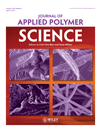Rigid polyurethane foam based on modified vegetable oil
Abstract
Soybean oil and castor oil were modified and used to prepare rigid polyurethane foam with similar properties to a commercial foam used for thermal insulation applications. Soybean oil was firstly modified according to a peracid method, using formic acid and hydrogen peroxide to yield a formiated soy polyol. Furthermore, transesterification was performed with a polyfunctional alcohol to increase OH-functionality. Castor oil, which has hydroxyl groups in the molecular structure, was only transesterified. The vegetable polyols were characterized by OH-number, Brookfield viscosity, differential scanning calorimetry, and size exclusion chromatography. The foams were prepared at constant NCO/OH ratio (1.2 : 1) by the hand mix method and poured into a closed steel box. They were characterized using scanning electron microscopy, thermogravimetric analysis, and dynamic mechanical analysis. The apparent density and the compression strength of foams were determined, respectively, by the mass/volume relation and through the table tensile tester. After modification, the polyols reached an OH-number between 393 and 477 mg KOH/g oil, showing a low viscosity and molecular weight, allowing the preparation of a rigid vegetable foam with an apparent density of 50 ± 1 kg/m3 and compression strength around 200 kPa. © 2010 Wiley Periodicals, Inc. J Appl Polym Sci, 2010




